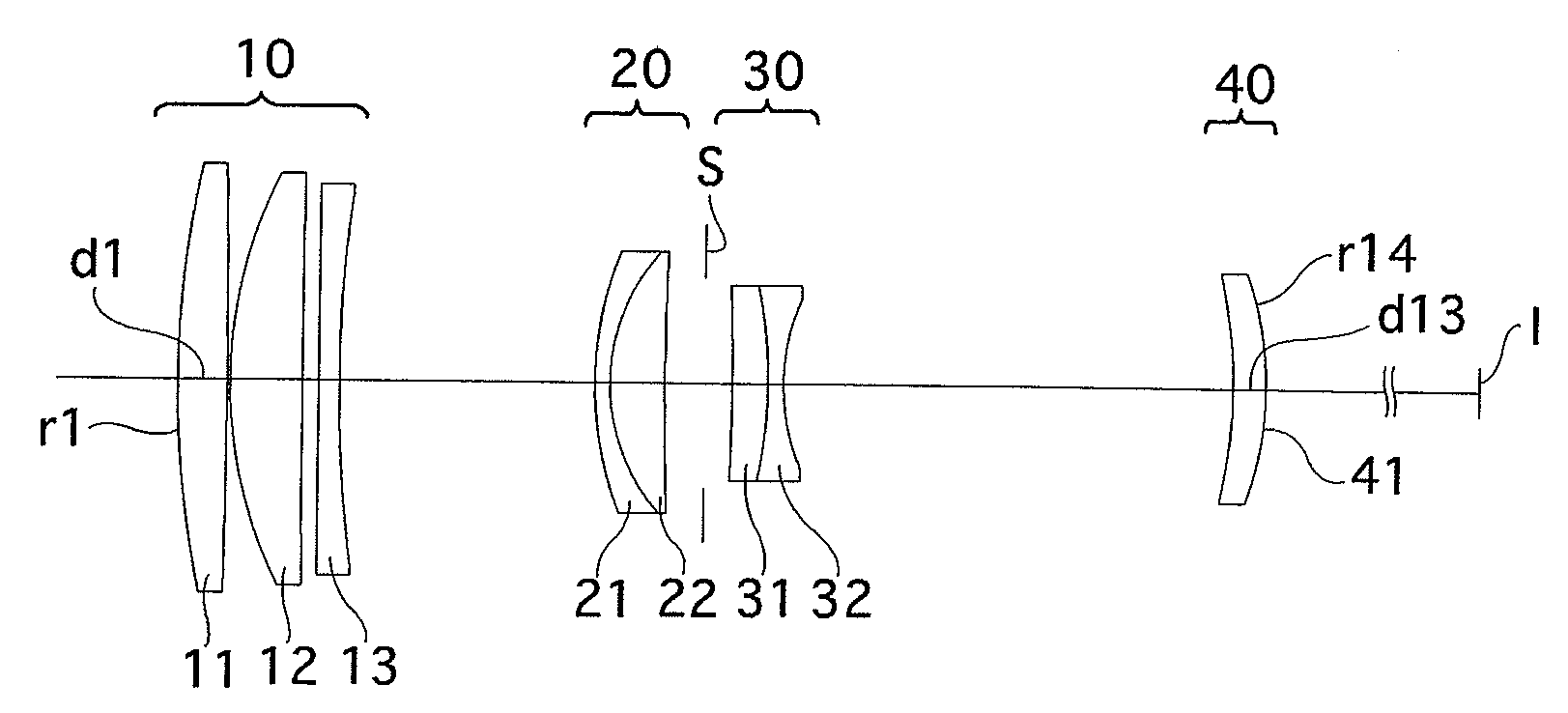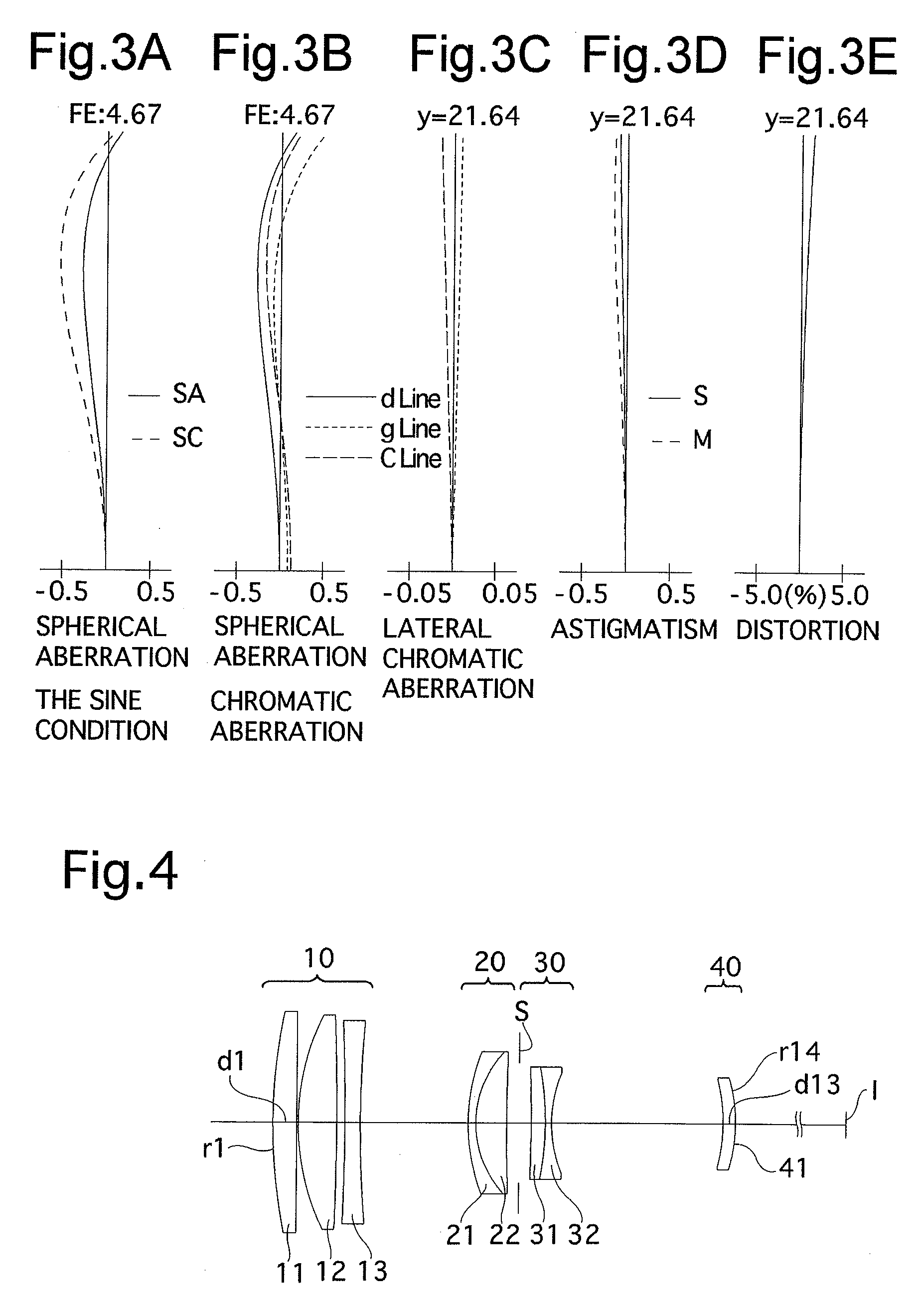Telephoto lens system
a telephoto lens and lens group technology, applied in the field of telephoto lens systems, can solve the problems of heavy weight of the lens group to be moved, inability to achieve a higher-speed focusing capability, and inability to move the lens group internally, so as to achieve the effect of shortening the minimum photographic distance and reducing distortion and spherical aberration
- Summary
- Abstract
- Description
- Claims
- Application Information
AI Technical Summary
Benefits of technology
Problems solved by technology
Method used
Image
Examples
embodiment 1
[0098]FIG. 1 shows the lens arrangement of the first embodiment of the telephoto lens system according to the present invention, when an object at infinity is in an in-focus state.
[0099]FIGS. 2A through 2E show aberrations occurred in the lens arrangement shown in FIG. 1, when an object at infinity is photographed.
[0100]FIGS. 3A through 3E show aberrations occurred in the lens arrangement shown in FIG. 1, when an object at a closer distance is photographed.
[0101]Table 1 shows the numerical data of the first embodiment.
[0102]The positive first lens group 10 (surface Nos. 1 through 6) includes a positive biconvex lens element (first lens element) 11, a positive meniscus lens element (second lens element) 12 having the convex surface facing toward the object, and a negative lens element (third lens element) 13 having a flat surface facing toward the object, in this order from the object.
[0103]The positive second lens group 20 (surface Nos. 7 through 9) includes a negative meniscus lens...
embodiment 2
[0107]FIG. 4 shows the lens arrangement of the second embodiment of the telephoto lens system according to the present invention, when an object at infinity is in an in-focus state.
[0108]FIGS. 5A through 5E show aberrations occurred in the lens arrangement shown in FIG. 4, when an object at infinity is photographed.
[0109]FIGS. 6A through 6E show aberrations occurred in the lens arrangement shown in FIG. 4, when the object at a closer distance is photographed.
[0110]Table 2 shows the numerical data of the second embodiment.
[0111]In the positive first lens group 10, the first lens element 11 is a positive meniscus lens element having the convex surface toward the object, the second lens element 12 is a positive biconvex lens element, and the third lens element 13 is a negative biconcave lens element. Except the arrangement of the positive first lens group 10, the other lens arrangements are the same as that of the first embodiment.
[0112]The diaphragm S is provided 4.000 in front of (on...
embodiment 3
[0113]FIG. 7 shows the lens arrangement of the third embodiment of the telephoto lens system according to the present invention, when an object at infinity is in an in-focus state.
[0114]FIGS. 8A through 8E show aberrations occurred in the lens arrangement shown in FIG. 7, when an object at infinity is photographed.
[0115]FIGS. 9A through 9E show aberrations occurred in the lens arrangement shown in FIG. 7, when the object at a closer distance is photographed.
[0116]Table 3 shows the numerical data of the third embodiment.
[0117]The basic lens arrangement of the third embodiment is the same as that of the first embodiment.
[0118]The diaphragm S is provided 4.000 in front of (on the object side of) the negative third lens group 30 (surface No. 10).
TABLE 3FNO. = 1:4.1f = 290.98W = 4.2fB = 53.98m = 0.00-−0.02-−0.25Surf. No.rdNdν1159.0148.091.4874970.22−1026.9640.50——379.16210.551.4387595.04948.7399.15——5∞3.501.8040039.56186.30542.15——755.5472.871.7439945.8832.5949.231.4970081.691795.98014.1...
PUM
 Login to View More
Login to View More Abstract
Description
Claims
Application Information
 Login to View More
Login to View More - R&D
- Intellectual Property
- Life Sciences
- Materials
- Tech Scout
- Unparalleled Data Quality
- Higher Quality Content
- 60% Fewer Hallucinations
Browse by: Latest US Patents, China's latest patents, Technical Efficacy Thesaurus, Application Domain, Technology Topic, Popular Technical Reports.
© 2025 PatSnap. All rights reserved.Legal|Privacy policy|Modern Slavery Act Transparency Statement|Sitemap|About US| Contact US: help@patsnap.com



